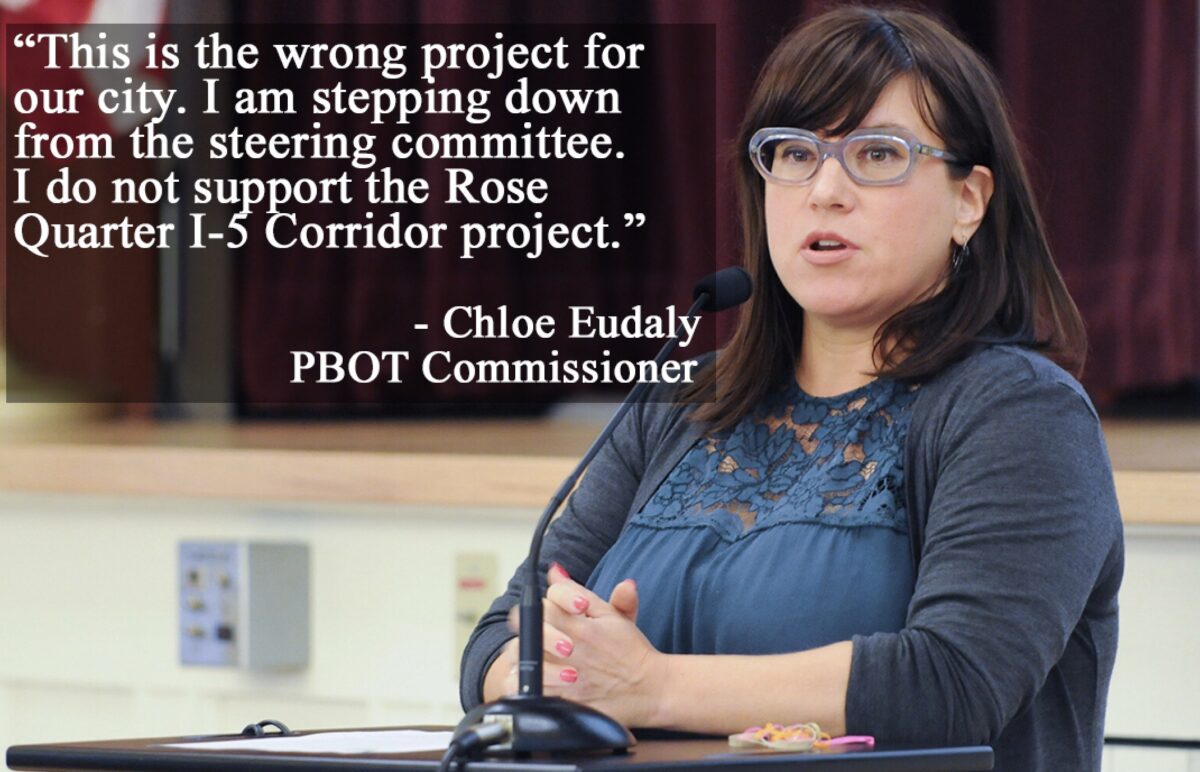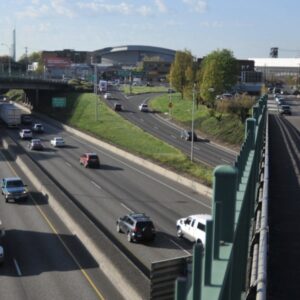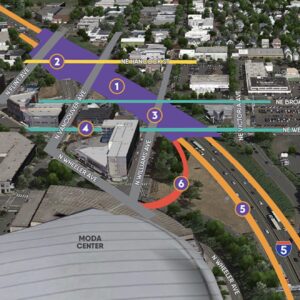The Oregon Department of Transportation lost a lot more than the support of a local nonprofit today when Albina Vision Trust pulled their support of the I-5 Rose Quarter project.
That earthquake has already had major aftershocks. Portland Bureau of Transportation Commissioner Chloe Eudaly and Portland Mayor Ted Wheeler have both pulled their support as well. This means ODOT is left trying to complete a controversial mega-project that doesn’t have support from the very city it would be built in.
And while we’re still estimating the damage, ODOT says they’ll try to do better. “We’ve been actively working to address our partners’ concerns,” ODOT Urban Mobility Office Director Brendan Finn shared with us today. “There is clearly more work to do, and we will be part of the solution moving forward.”
Before we consider what happens next, let’s see how Commissioner Eudaly and Mayor Wheeler frame their new positions.
Mayor Wheeler tweeted this earlier today:
With the history of transportation infrastructure dividing communities, it is critical that entities like Albina Vision, which champions restorative justice, equity, and forward-thinking – are at the table for this process. At every step, I have asked ODOT for specific goals to be met around climate, community, and economic development. Those goals have not been met. Therefore, I am withdrawing my support for the I-5 Rose Quarter Project.
Wheeler’s statement is good politics, but it makes him appear more skeptical of the project than he actually was. As we reported in 2017 he used to defend the project and even dismissed people who opposed it as being “ridiculous”.
And here’s the statement Commissioner Eudaly released today:
“From the beginning, I’ve made it clear that the Rose Quarter I-5 project did not fit the priorities or values of PBOT, the City of Portland, or myself. While the interchange is poorly designed and could stand to be reconfigured, it was hard to justify such a huge investment in a project that would not significantly decrease serious injuries and fatalities on our roadways and would deliver a very modest and short-lived decrease in congestion and carbon emissions. Approximately half of Portland’s traffic fatalities happen on ODOT properties, which only make up 12% of our roadways. There are many more urgent and worthy projects if you value human life.
The Rose Quarter I-5 corridor is a monument to the racist legacy of our transportation system. In 1962, ODOT dug a trench through Oregon’s largest Black community, demolishing 300+ plus homes, disrupting and destabilizing the community, and polluting the environment. The only consolation of this project in my opinion, was the promised investment in the surface streets, and in particular the caps, that were intended to help stitch Lower Albina back together and pave the way for development focused on racial equity and restorative justice.
Advertisement
At every step of this process I have fought for community interests and demands—we had some wins and losses. Portland City Council made congestion pricing a requirement for the project through the Comp Plan. I successfully advocated for ODOT to hold a public hearing, extend the comment period, and create an executive steering committee. But despite the fact the City, County, Metro, and Portland Public Schools—along with hundreds of community members—called for a full Environmental Impact Study (EIS), the OTC determined that a much less rigorous Environmental Assessment (EA) would suffice. We then pivoted to outcomes for the Black community, working closely with Albina Vision Trust.
However, after the first executive steering committee, it became clear to me that ODOT was determined to move forward with the project as planned, that they were resistant to congestion pricing, that the steering committee was to be treated as an advisory body with no governing authority, that ODOT did not seem to grasp the concept of restorative justice, and we were unlikely to achieve the outcomes we were seeking. I am so pleased that so many of us have now come to the same conclusion. This is the wrong project for our city. I am stepping down from the steering committee. I do not support the Rose Quarter I-5 Corridor project. And I urge the state to prioritize safety, climate change, and racial justice in all future transportation investments.
Eudaly echoes some of the frustration shared by leaders of the Albina Vision Trust — that despite months of letters and public comments ODOT isn’t taking the community’s values seriously enough.
It’s unclear what all this means to the project. It’s a major body blow, but the fight is far from over.
What we do know is that the support of PBOT and the City of Portland has been used by ODOT from the very beginning as a firewall against opposition. ODOT has always known that Portland would be the hardest place to expand a freeway in the entire state. Portland is legendary for its transportation activism (made even stronger by teaming up with climate change activists) and ODOT is deeply disliked in Portland for myriad reasons (from their love of big freeways to their deadly arterials). Many activists and bureaucrats see ODOT as the prime suspect in many crimes against safe and sustainable transportation. Having PBOT on the team gives them a progressive front to smooth those rough edges.
For their part, ODOT likes to claim the Rose Quarter project was already endorsed by Portland City Council and that the two agencies have “a unique collaborative partnership.” The truth is Portland City Council has only adopted a conceptual freeway project in long-range planning documents, they’ve never voted specifically on ODOT’s widening project. That’s why Portland Planning Commissioner (and Metro Council candidate) Chris Smith tried to force that vote with some procedural maneuvering in 2017. Smith’s gambit didn’t work, so he took a different route and helped form No More Freeways, a group that would become the project’s chief antagonist.
The fact is, if Portland City Council were to vote on the I-5 Rose Quarter project today, it would not have enough votes to pass.
But the fact also is, the expansion of I-5 in the Rose Quarter is part of several key adopted plans like the Transportation System Plan and Metro’s Regional Transportation Plan.
While there’s been well-deserved celebration from transportation reformers today, this project is far from dead. ODOT believes they have a mandate from the Oregon Legislature who enshrined funding for the project into law in 2017. Getting ODOT and state lawmakers to re-allocate funds already earmarked for a freeway expansion to other uses would take another, more powerful earthquake.
Asked for a response to today’s big news, ODOT Urban Mobility Office Director Brendan Finn didn’t sound too worried.
“We acknowledge that historic transportation investments caused harm to the African American Albina community,” Finn said. “We are committed to doing business differently… As we move forward, we hope to engage our partners in further discussion to earn the community’s trust – not through words but through actions. We’ve got to get it right and meet the community’s needs – we will keep showing up to do just that.”
Will ODOT win back support of Portland-area electeds and organizations? Is it even possible for a freeway expansion project to meet climate change, racial and social justice goals? How much more time and money will ODOT spend trying to convince us that it is?
— Jonathan Maus: (503) 706-8804, @jonathan_maus on Twitter and jonathan@bikeportland.org
— Get our headlines delivered to your inbox.
— Support this independent community media outlet with a one-time contribution or monthly subscription.







Thanks for reading.
BikePortland has served this community with independent community journalism since 2005. We rely on subscriptions from readers like you to survive. Your financial support is vital in keeping this valuable resource alive and well.
Please subscribe today to strengthen and expand our work.
I’m curious how Tina Kotek can possibly continue to support the project after all this…
The irony here is that the Oregon legislature and governor who are ramming this highway project through liberal urban Portland are Democrats.
I’m not sure if one can still call it ironic if the Democrat party has been neoliberal since the 90’s. Nearly 30 years on, surely this is no longer contrary to expectations.
Thank you, John.
In a political state of >90% in the hands of one party…it is not surprising that there would be a broad spectrum of actions and opinions within one party especially diverting from its origins. A dominant majority is just that…one that can maximize its hold on power as it chooses while minimizing its minor voices and ideas that third and fourth parties can help magnify and empower vs. placate or smother…
https://www.pacificgreens.org
Just as an aside, a great way to help empower those third/fourth/etc voices would be implementing STAR voting to replace our current plurality voting system. STAR voting almost passed in Lane county last election cycle – I believe it’s back on the ballot for Eugene next cycle. Gotta start somewhere!
A zombie freeway project. Great.
Re: Pacific Green Party: I was a member for quite a few years because it best aligned with my values, but finally switched my registration to the Democratic Party when I realized it kept me from participating in Oregon’s closed primary system.
I change my party affiliation so I can vote in the primary I want to vote in and then back to the party I feel most closely represents me. It takes less than 2 minutes.
ODOT=Mad bull, lost it’s way.
Note for JM about the site: How come we need to log in to vote? That means subscribing, creating a login, etc. Some of us don’t follow the site closely enough to do all that. But maybe you covered it already and I missed it. Anyway, I’m seeing very few votes anymore, making the up- and down-votes pretty meaningless.
We’re experimenting with this to learn more about how people are using the voting system. I realize the vast majority of readers are not subscriber/supporters and therefore don’t have a login. And yes I agree that such low vote counts renders them pointless. I am likely going to deem this experiment over soon and go back to allowing everyone to comment. Thanks for the feedback.
The thing I’m most pleased about in this situation is how AVT has exposed ODOT’s ILLUSION OF INCLUSION (trademark), which is actually a practice of most Oregon public agencies: they decide what they want to do and then begin a “public involvement” process that allows them to say they *listened* to all views, as they then proceed with their original plan. They employ expensive “public involvement” consultants who put people in groups and allow them to put colored stickers on whiteboards. It all adds up to a huge waste of time and money. I’m so glad AVT called BS on ODOT’s process.
ODOT: 100% full employment for any and all Public Involvement consultants and gratuitous Post-it Note consumption.
This reminds me of that movie from 2004, “Downfall.” ODOT is like the actor Bruno Ganz and his crew in the bunker in denial that things are going badly for them.
While I agree that the people of Berlin (Portland) no longer support the central regime (ODOT), the regime and their leadership (Governor Kate Brown, ODOT Vice-Chancellor for Public Works Kris Stickler, and Minister for Propaganda Brendan Finn) still has solid support from folks throughout the rest of Germany (or at least the Oregon state legislature). Portland’s only allies in this is really the Covid-19 shutdown and a continued loss of revenue from people not driving as much (and a temporary loss of federal funding), which ultimately may (or may not) starve this project of funding, depending how quickly an effective vaccine is developed. But the loyal people of Deutschland-Oregon still solidly support this freeway expansion, even if the traitors in it’s largest city do not. And I’m still uncertain who the Soviets are in this strange analogy.
I’m a registered Independent because I came to believe that neither Tina Kotek, nor Kate Brown have the courage to listen to voices of color in State transport planning. Its criminal what ODOT has done to NEPA processes. We could have completed an EIS years ago but these Democratic leaders gave power to freeway building when the promoted Strickland to the Director Role. He is not an advocate for change, he is the gatekeeper the status quo happy to be building bridges and relationships with the Idaho DOT after the flood. And IDK if I need to remind you but last spring Idaho was trying to expand its statehood boundary to the coast. We have an a lot of rural conservatives who ‘own’the transport network and they dont gove a dam if PDX burns to the ground. So everyday Strickland is in charge I want you to wonder just what is he talking about with Idaho DOT’ the same people who annex Oregon. I’m a visionary with 85% accuracy and something stinks big time at ODOT. Start at the top to address racism and the violent history of road building and eminent domain at the end of the Oregon Trail. Who’s buck stops where? The engineering profession has a long standing g issue with racism and recruiting people of color. These are the guys running ODOT right now. And just a gentle reminder DOTs where spun out of police departments to enforce racist transport policies. Know your history. Fire Strickland.
Idaho department of transportation are annexing Oregon? Um. OK.
His name is Kris Strickler fyi (ODOT director)
Isn’t Strickland the Principal at Hill Valley High School?
He also played PG for the Blazers a few years back…
Imagine how much alternative infrastructure we could build with this money.
We can imagine, but they are state highway funds that will be redistributed by the state legislature to other projects.
I just don’t understand how the caps would have accomplished anything, for any community interest.
Housing in the area where housing was destroyed from original I-5 construction
There wasn’t housing planned for the caps and the load that the caps could handle was relatively limited.
And then what?
Gov. Brown just piled on.
Thank you for the link.
The following could just as easily mean that the governor agrees with the Mayor, but it could also mean that the governor and ODOT haven’t given up yet in maneuvering local black opinion their way:
“It’s my hope that this particular project can be part of righting historic wrongs, and I’m committed to bringing people back to the table for that discussion,” the governor said.
Brown’s office did not immediately respond to questions about the comment, such as whether the governor would be willing to pull the plug on the project altogether if an agreement couldn’t be reached, and whether she’d ordered ODOT to hold off on further action.
“We’re aligned with the governor,” ODOT Urban Mobility Office director Brendan Finn said in a statement. “The partnerships and support with the Black community is key to success of the project and we look forward to continuing that work.”
ODOT Rose Quarter I-5 project 2.0: Same design, add “African” design motif murals and a 1,200 sq ft traffic island named George P. Floyd Memorial Plaza.
Mission accomplished!
What ODOT could do is set aside 1% of the budget ($5 million-$10 million) for public art (as the state already does for public building projects), and exclusively commission Albina black artists for the installations. I bet that would go a long way in appeasing local black critics.
Classic colonial playbook.
It might be performative but could the Portland City Council officially rescind their past support for the project?
Note that ODOT thinks ripping a freeway through the black part of town was an “investment”. What a shameful thing to (still!) be saying, Mr Finn.
> “We acknowledge that historic transportation investments caused harm to the African American Albina community,” Finn said.